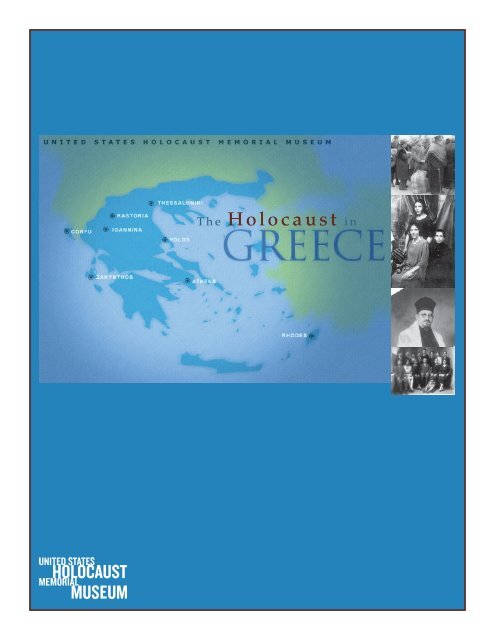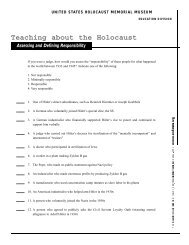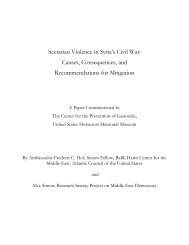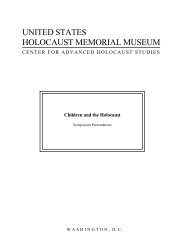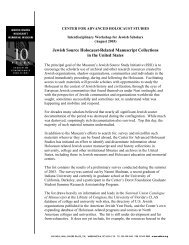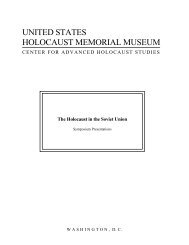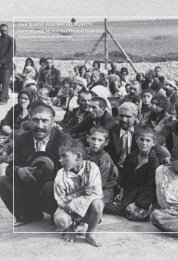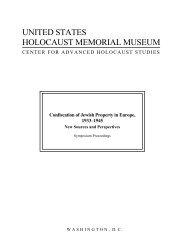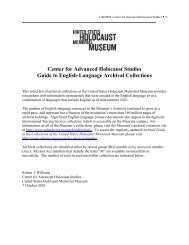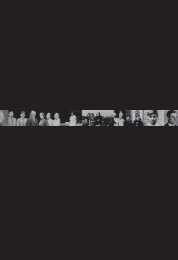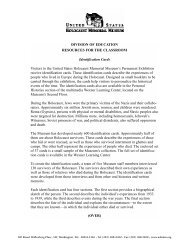Download PDF - United States Holocaust Memorial Museum
Download PDF - United States Holocaust Memorial Museum
Download PDF - United States Holocaust Memorial Museum
You also want an ePaper? Increase the reach of your titles
YUMPU automatically turns print PDFs into web optimized ePapers that Google loves.
The <strong>Holocaust</strong> in
The <strong>Holocaust</strong> inGREECETable of ContentsIntroduction................................ 1Athens....................................... 3Corfu........................................ 5Ioannina..................................... 7Kastoria..................................... 9Thessaloniki...............................11Volos.......................................13Rhodes.....................................15Zakynthos..................................17Bibliography...............................19<strong>United</strong> <strong>States</strong> <strong>Holocaust</strong> <strong>Memorial</strong> <strong>Museum</strong>
corfuKastoriaioanninaThessalonikivolosThe <strong>Holocaust</strong> inzakynthosathensrhodesINTRODUCTIONMordechaiFrezis, a Jewfrom Chalkis,was one of thefirst Greekofficers to diein World WarTwo.Kehila KedoshaJanina Synagogueand <strong>Museum</strong>, NYThe indigenous Jewish communities of Greece represent the longestcontinuous Jewish presence in Europe. These communities, alongwith the Jews who settled in Greece after their expulsion fromSpain, were almost completely destroyed in the <strong>Holocaust</strong>.The Germans defeated the Greek army in the spring of 1941and occupied Greece until October 1944. The country wasdivided into three zones of occupation: Bulgaria annexed Thraceand Yugoslav Macedonia; Germany occupied Greek Macedonia,including Thessaloniki, Piraeus, and western Crete; and Italyoccupied the remainder of the mainland and the islands. WhereJews resided determined not only their subsequent fate but alsotheir ultimate possibility of escape.U n i t e d S t a t e s H o l o c a u s t M e m o r i a l M u s e u m1
Greek resistance groups, both communist andnoncommunist, battled the Axis occupiers in aneffort to save not only Greece but also the Jewsliving there. Between 8,000 and 10,000 GreekJews survived the <strong>Holocaust</strong>, due in large partto the unwillingness of the Greek people,Members of ELAS, the Popular Greek Libertion Army including leaders in the Greek OrthodoxDr. Michael MatsasChurch, to cooperate with German plans forthe deportation of Jews. In addition, Italianoccupying authorities refused to facilitate or permit deportations from the Italian zone of occupationuntil Italy surrendered in September 1943.Even though deportations did not start untilMarch 1943, Greece lost at least 81percent of its Jewish population during the<strong>Holocaust</strong>. Between 60,000 and 70,000 GreekJews perished, most of them at Auschwitz-Birkenau.The deportation of Jews in Thrace, March 1943Jewish <strong>Museum</strong> of GreeceU n i t e d S t a t e s H o l o c a u s t M e m o r i a l M u s e u m2
ThessalonikiCorfuKastoriaioanninavolosThe <strong>Holocaust</strong> inzakynthosAthensrhodesCcorfuThe island of Corfu in the Ionian Sea had been home to Jewsfor over 800 years. When the Venetians annexed the island in thefourteenth century, they enclosed the Jewish community in aghetto. The island’s Jewish population was a mix of Greek-speakingRomaniotes, Ladino-speaking Sephardim, and Italian-speakingJews from Apulia and Sicily. The relationship between Jews andChristians on the island had been soured by a notorious “Blood Libel”investigation conducted in 1891.The story of the <strong>Holocaust</strong> in Corfu is especially unfortunate, in partbecause it occurred late in the war. The Germans took control of theisland in 1943 after the fall of Italy and promulgated antisemitic laws.Corfu’s Mayor Kollas was a known collaborator.In early June 1944, as the Allies bombed the island to divert attentionfrom the landing at Normandy, German SS and local Greek policeforced the Jews of Corfu out of their homes and imprisoned them inU n i t e d S t a t e s H o l o c a u s t M e m o r i a l M u s e u m 5
ThessalonikicorfuKastoriaIoanninavolosThe <strong>Holocaust</strong> inzakynthosAthensrhodesIIOANNINAEvidence dates the presence of Jews in Ioannina to 70 CE. The IoanninaJews formed a Romaniote community, composed of Greek Jews alreadysettled in the city before the influx of Sephardim in the fifteenth and sixteenthcenturies. Unlike other Jewish communities of the period, the Jewsin Ioannina preserved their Romaniote culture and continue to maintainthat culture and special liturgy today.Initially, Ioannina was occupied by the Italians, and Jews did not experienceany discrimination until Italy surrendered in September 1943.After the Germans took over, Jewish leaders adopted a wait-and-seepolicy, hoping that the Germans would leave them alone as well. TheGermans told members of the communities that what had happenedin Thessaloniki would not happen in Ioannina because the IoanninaJews, as Greek speakers, were not akin to the Ladino-speaking Jews ofThessaloniki.U n i t e d S t a t e s H o l o c a u s t M e m o r i a l M u s e u m 7
In March 1944, however, the president ofthe Jewish community in Ioannina, Dr. MosesKoffinas, was arrested. While detained, he learnedof Germany’s plans to deport Jews, and he smuggleda note out to Sabetai Kabelis, a prominentmember of the Jewish Community Board, advisingthe Jews to flee. Unfortunately, Kabelis chosenot to relay the warning to Ioannina’s Jews, andon March 25, 1944, the entire Jewish communityof 1,860 people, including Kabelis himself, was deported toAuschwitz-Birkenau.The deportation of Jews, March 25, 1944Kehila Kedosha Janina Synagogue and <strong>Museum</strong>TorahsMarcia Haddad IkonomopoulosA <strong>Holocaust</strong> memorial inIoanninaMarcia Haddad IkonomopoulosU n i t e d S t a t e s H o l o c a u s t M e m o r i a l M u s e u m8
corfuKastoriaioanninaThessalonikivolosThe <strong>Holocaust</strong> inzakynthosAthensrhodesKKASTORIAKastoria is located on an ancient trade route in the mountains betweenThessaloniki and Ioannina. Many of Kastoria’s Jews were employed inthe manufacturing of fur and leather items, for which the city becamefamous. Kastoria was a Sephardic community, although there isevidence that a Jewish community existed there before the fifteenthcentury.Like Thessaloniki, thecity was part of theOttoman Empire untilthe Balkan Wars inthe early twentiethcentury, when it wasliberated by Greece.A Jewish family before the deportationsJewish <strong>Museum</strong> of GreeceU n i t e d S t a t e s H o l o c a u s t M e m o r i a l M u s e u m 9
There were 900 Jews in Kastoria in 1940. OnMarch 25, 1944, 763 of them were roundedup for deportation, first to Thessaloniki and thento Auschwitz-Birkenau. Prior to their deportation,they were enclosed in an abandoned school fordays, with no food or water, and the young girlswere raped by German soldiers. Thirty-five Jewssurvived the <strong>Holocaust</strong> in Kastoria. In 1996, aThe dedication of a <strong>Holocaust</strong> memorial inKastoria in 1996Jewish <strong>Museum</strong> of Greece<strong>Holocaust</strong> memorial was dedicated in honor ofthe vicitms.U n i t e d S t a t e s H o l o c a u s t M e m o r i a l M u s e u m10
ThessalonikicorfuKastoriaioanninavolosThe <strong>Holocaust</strong> inzakynthosAthensrhodesTTHESSALONIKIFor centuries, Thessaloniki, honored with the title “LaMadre de Israel,” was the most populous city of SephardicJewry in the world.In the summer of 1942, the persecution of the Jews ofThessaloniki started. All men between the ages of 18 and 45were conscripted into forced labor, where they stood for hoursin the hot summer sun and were beaten and humiliated. TheJewish community was depleted of its wealth and pride. Jewswere ordered to wearthe yellow Star of Davidand forced into anenclosed ghetto, calledBaron Hirsch, adjacentto the rail lines.The persecution of Jews, summer 1942Jewish <strong>Museum</strong> of GreeceU n i t e d S t a t e s H o l o c a u s t M e m o r i a l M u s e u m 11
On March 15, 1943, the Germans began deporting Jews from Thessaloniki. Every three days,freight cars crammed with an average of 2,000 Thessaloniki Jews headed toward Auschwitz-Birkenau.By the summer of 1943, German authorities had deported 46,091 Jews.Several factors contributed to the loss of such a large number of Jews from Thessaloniki.Thessaloniki was under direct German occupation. The Jewish community was highly concentratedin the city. Jews had no idea that they were going to killing centers; they believed the Germansubterfuge that they were going to work in Poland. Moreover, the controversial head rabbi, ZviKoretz, reportedly assisted the Germans in organizing efficient roundups. Because Ladino was thefirst language of Thessaloniki Jews, their spoken Greek was easy to distinguish. While the possibilityof escape existed, most Jews, fearing separation from their families, did not take advantage of theavailable options.Thessaloniki lost 94 percent of its Jewish population in the <strong>Holocaust</strong>.Identification cards andyellow Stars of David issuedby Germans and signed byRabbi KoretzJewish <strong>Museum</strong> of GreeceU n i t e d S t a t e s H o l o c a u s t M e m o r i a l M u s e u m12
ThessalonikicorfuKastoriaioanninaThe <strong>Holocaust</strong> inVoloszakynthosAthensrhodesVVolosVolos, an important port city on the Aegean Sea, south of Thessaloniki,has had a Jewish presence since the fourteenth century. There is evidencethat Jews have existed in the surrounding areas since ancient times.In 1940 there were 882 Jews living in Volos. With the occupation ofGreece, Volos was placed in the Italian zone and Jews lived in relativesafety until the Germans took over in September 1943.While the Italians were in power, Jews fleeing Nazi persecution inThessaloniki sought sanctuary in Volos.The resistance movement was very active in Volos. The chief rabbi,Moshe Pessah, worked with Archbishop Joachim Alexopoulos and theEAM (Nationl Liberation Front) to find sanctuary for the city’s Jews in themountainous villages of Pelion.U n i t e d S t a t e s H o l o c a u s t M e m o r i a l M u s e u m 13
Chief Rabbi Moshe PessahRaphael Frezis, President of the JewishCommunity of VolosArchbishop Joachim AlexopoulasRaphael Frezis, President of the JewishCommunity of VolosThe Germans chose March 25, 1944, Greek Independence Day, to deport the Jews of Volosand any Jews remaining on the Greek mainland. Due to the valiant efforts of Rabbi Pessah,Archbishop Joachim (who is honored at Yad Vashem as “Righteous Among the Nations), andthe EAM, 74 percent of Volos’s Jews were saved. Of more than 1,000 Jews living in the city inMarch 1944, only 130 were deported to Auschwitz-Birkenau.Devastating earthquakes in 1955–57 forced many of the remaining Jews to leave Volos, andmost immigrated to the <strong>United</strong> <strong>States</strong> and Israel.U n i t e d S t a t e s H o l o c a u s t M e m o r i a l M u s e u m14
ThessalonikicorfuKastoriaioanninavolosThe <strong>Holocaust</strong> inzakynthosAthensRhodesRRhodesFor 2,300 years, Jews have lived on the island of Rhodes at the southern tip ofthe Aegean Sea. The community became Sephardic in the sixteenth century,and was among the most renowned Sephardic communities in the world. Thesynagogue in Rhodes, Kahal Shalom, was built in 1575 and is the oldest functioningsynagogue in Greece.Rhodes was part of Italy duringWorld War II, having been cededto the Italians after World War I.As with other areas under Italianoccupation, the Jews of Rhodesremained relatively safe until theGermans occupied the island inSeptember 1943.The Kahal Shalom Synagogue, built in 1575Jewish Community of RhodesU n i t e d S t a t e s H o l o c a u s t M e m o r i a l M u s e u m15
In 1944 there were close to 2,000 Jews living on the island,50 of whom, as Turkish citizens, fell under the protection ofthe Turkish consulate. The rest were deported on July 20,1944.The timing of the deportation is especially painful since, lessthan three months later, the Germans were forced to leaveGreece. Deportations from Rhodes were the last conductedby the Germans in Greece.On July 20, 1944, the Jews of Rhodes and the neighboringisland of Kos were sent by boat to the Greek mainland.Crammed together in the hot summer sun, without food orwater, 23 Jews died on the voyage to the mainland. Thosewho survived were incarcerated in the SS-operated transitcamp Haidary and thendeported by train to Auschwitz-Birkenau. Only 151 Jews fromRhodes survived the <strong>Holocaust</strong>.Yehuda Levy and his family in 1928.Yehuda and his wife, Miriam Notrica,died at Auschwitz- Birkenau in August1944.Stella Levy and Aron Hasson, RhodesYodef Levy and DonaHabif, April 1944. Bothdied at Auschwitz-Birkenau.Aron Hasson, RhodesHistorical SocietyU n i t e d S t a t e s H o l o c a u s t M e m o r i a l M u s e u m16
ThessalonikicorfuKastoriaioanninavolosThe <strong>Holocaust</strong> inZakynthosAthensRhodesZZAKYNTHOSAlthough the Jews of Zakynthos share a similar history with the Jewsof the Ionian islands, all 275 Zakynthos Jews survived the <strong>Holocaust</strong>.The courageous actions of Bishop Chrysostomos and Mayor LoukasKarrer in helping save Zakynthos Jews led Yad Vashem to recognizethem as “Righteous Among the Nations.”In 1944 Mayor Loukas Karrer wasordered at gunpoint to hand over a listof Jews residing on the island. The list,presented to the Germans by BishopChrysostomos, contained only two names:Mayor Karrer and Bishop Chrysostomos.The bishop bravely told the Germans,“Here are your Jews. If you choose todeport the Jews of Zakynthos, you mustalso take me, and I will share their fate.”Mayor Loukas KarrerJewish <strong>Museum</strong> of GreeceU n i t e d S t a t e s H o l o c a u s t M e m o r i a l M u s e u m 17
In the interim, all the Jews of the island were safelyhidden in the mountainous villages. Though the wholeisland knew what was happening, not one personrevealed their whereabouts.There is evidence that Chrysostomos actually communicatedwith Hitler himself to beg for the lives of the Jewson the island. Unfortunately, a devastating earthquakeThe Mordos family before World War IIKehila Kedosha Janina Synagogue and <strong>Museum</strong> in 1953 destroyed allarchives on the island,making proof of thecorrespondence impossible. Historians do know that a boat wasnever sent to deport the Jews of Zakynthos and that all 275 of theisland’s Jews survived the <strong>Holocaust</strong>.The first boat to arrive with aid to the victims of the 1953 earthquakewas from Israel, with a message that read, “The Jews ofZakynthos have never forgotten their mayor or their belovedbishop and what they did for us.”Bishop ChrysostomosJewish <strong>Museum</strong> of GreeceU n i t e d S t a t e s H o l o c a u s t M e m o r i a l M u s e u m18
BBIBLIOGRAPHYGeneral Bibliography on the <strong>Holocaust</strong> in GreeceSelected Articles in Scholarly JournalsIndividual CommunitiesThessaloniki (Salonika)IoanninaVolosRhodes<strong>Holocaust</strong> MemoirsPropaganda leaflet(“The Subhuman”)Jewish <strong>Museum</strong> of GreeceFleischer, Hagen. Greek Jewry and Nazi Germany: The<strong>Holocaust</strong> and Its Antecedents. Athens: GavrielidesPublishing, 1995.Examines the extent of assimilation of the variousJewish communities in Greece and speculates on howthe assimilation affected their ability to survive the<strong>Holocaust</strong>.As cited in Documents on the History of the GreekJews: Records from the Historical Archives of theMinistry of Foreign Affairs. Athens: KastaniotisEditions, 1998.ISBN 960 03 2330 5Kampanellis, Iakovos. Mauthausen. Athens: KendrosPublishers, 1995.Describes life in one of the harshest Nazi concentrationcamps, as told by a Greek prisoner. Basis for MikisTheodorakis’s Mauthausen.ISBN 960040979XLévy, Dr. Isaac Jack. And the World Stood Silent:Sephardic Poetry of the <strong>Holocaust</strong>. University ofIllinois Press, 1989.Includes <strong>Holocaust</strong> poetry written by Greek Jews, inoriginal Greek and Judeo-Spanish.ISBN 0252015800General Bibliography on the <strong>Holocaust</strong> in GreeceBedford, Robert. An Introduction to Literature on the<strong>Holocaust</strong> in Greece. New York: Sephardic HistoricalCommittee, 1994.ISBN 1886857008Constantopoulou, Photini, and Thanos Veremis.Documents on the History of the Greek Jews. Athens:Kastaniotis Editions, 1997.Monumental work compiled by the Greek Ministry ofForeign Affairs and the University of Athens. Presentsrepresentative documents on the modern history ofGreek Jewry, including many original documentsrelated to the <strong>Holocaust</strong>.ISBN 9600317275Matsas, Dr. Michael. The Illusion of Safety: The Storyof Greek Jews during the Second World War. PellaPublication, 1997.Detailed account of the role of the resistance movementin helping Greek Jews. Explores the moralresponsibility of the <strong>United</strong> <strong>States</strong> and Great Britain,and how their choices not to disseminate informationto the Jews of Greece might have contributed to thegreat number of Greek Jews lost in the <strong>Holocaust</strong>.ISBN 0918618665Mazower, Mark. Inside Hitler’s Greece: The Experienceof Occupation 1941–1944. Yale University Press, 1993.ISBN 0300058047U n i t e d S t a t e s H o l o c a u s t M e m o r i a l M u s e u m19
Messinas, V. Elias. The Synagogues of Salonika andVeroia. Athens: Ekdoseis Gavrielides Editions, 1997.Pictures of and comments on many of the synagoguesdestroyed in the <strong>Holocaust</strong>, by noted Israeli architectElias Messinas, who worked on the restoration of thesynagogue in Veroia.ISBN 9603360104Plaut, Joshua Eli. Greek Jewry in the TwentiethCentury, 1913–1983: Patterns of Jewish Survival inthe Greek Provinces before and after the <strong>Holocaust</strong>.Associated University Press, 1996.Descriptions of Greek Jewish communities before the<strong>Holocaust</strong> and the remnants of Jewish life in Greeceafterward, with an emphasis on the Jews’ efforts tosurvive.ISBN 083863463XRosenbaum, Elie M., and William Hoffer. Betrayal: TheUntold Story of the Kurt Waldheim Investigation andCover-Up. New York: St. Martin’s Press, 1993.Details the role Kurt Waldheim played in the deportationof the Jews in Thessaloniki.ISBN 0312082193Stavroulakis, Nicholas. The Jews of Greece: An Essay.Athens: Talos Press, 1990.History of Greek Jews and their demise in the<strong>Holocaust</strong>.ISBN 9607459008Stavroulakis, Nicholas, and Timothy DeVinney. JewishSites and Synagogues of Greece. Athens: Talos Press,1992.Includes a history of each community and their fateduring the <strong>Holocaust</strong>.ISBN 9607459016Selected Articles in Scholarly JournalsAltsech, Moses B., and Y. Afrieronos. “Greek Jews andthe <strong>Holocaust</strong>.” Journal of the Hellenic Diaspora 23.2(1997): 29–60.General overview and individual stories of GreekJewish survivors.ISSN 0364-2976Bowman, Steven. “Jews in Wartime Greece.” JewishSocial Studies 48 (1): 45–62.Overview of Greek Jews and their destruction duringthe <strong>Holocaust</strong>.ISSN 0021-6704Gaon, Solomon, and Mitchell Serels. “Sephardim andthe <strong>Holocaust</strong>.” New York: J. E. Safra Institute ofSephardic Studies, Yeshiva University, 1987.Pages 38–56 discuss Ioannina; pages 55–80, Salonika;and pages 81–88, Rhodes.Kabeli, Isaac. “The Resistance of the Greek Jews.” YivoAnnual of the Jewish Social Sciences 8 (1953): 281–88.Kitroeff, Alexander. “The Jews in Greece, 1941–1944:Eyewitness Accounts.” Journal of the HellenicDiaspora 12 (3): 5–32.Documents relating to the <strong>Holocaust</strong> in Greece.ISSN 0364-2976Kreindler, Rabbi Joshua David. “Greece and the Jews.”Journal of Modern Hellenism 2 (1985): 113–17.Includes a translation of Archbishop Damaskinos’sletter to the Germans.ISSN 0743-7749Matsas, Joseph. “The Participation of the Greek Jewsin the National Resistance, 1940–1944.” Journal of theHellenic Diaspora 17.1 (1991): 55–68.ISSN 0364-2976Individual CommunitiesThessaloniki (Salonika)Ben, Joseph. “Jewish Leadership in Greece duringthe <strong>Holocaust</strong>: Patterns of Jewish Leadership in NaziEurope 1933–1945.” Proceedings of the Third YadVashem International Historical Conference, Jerusalem(1979): 335–52.Article on the role of Rabbi Koretz. As cited inDocuments on the History of the Greek Jews: Recordsfrom the Historical Archives of the Ministry of ForeignAffairs. Athens: Kastaniotis Editions, 1998.ISBN 960 03 2330 5U n i t e d S t a t e s H o l o c a u s t M e m o r i a l M u s e u m20
Eck, Nathan. “New Light on the Charges against theLast Chief Rabbi of Salonika.” Yad Vashem Bulletin 17(December 1965): 9–15 (a third missing); 19 (October1966): 28–35.Eck’s defense of Rabbi Koretz, stating that he wasinnocent and naive and not a German collaborator.A <strong>Holocaust</strong> memorial inVolos, dedicated in 1998Marcia Haddad IkonomopoulosJewish Community of Thessaloniki. “The JewishCommunity of Thessaloniki,” 1992.Pamphlet distributed by the Jewish community ofThessaloniki, providing the history of the communityand its destruction during the <strong>Holocaust</strong>.As cited in Documents on the History of the GreekJews: Records from the Historical Archives of theMinistry of Foreign Affairs. Athens: KastaniotisEditions, 1998.ISBN 960 03 2330 5Roth, Cecil. “Last Days of Jewish Salonica: WhatHappened to a 450 Year Old Civilization.”Commentary 10 (1): 49–55.Stavroulakis, Nicholas. Salonika, Jews, and Dervishes.Athens: Talos Press, 1993.IoanninaDalven, Rae. The Jews of Ioannina. Philadelphia:Cadmus Press, 1990.Comprehensive history of the Jews in Ioannina,including the detailed story of their deportationand annihilation during the <strong>Holocaust</strong>.ISBN 0930685032VolosCentral Board of Jewish Community of Volos. “TheJewish Community of Volos: Short Historical Review,”1993Translated publication that gives a brief historicaloverview of the community and the roles of RabbiPessah and Archbishop Joachim in helping to savemost of the Jews of Volos.RhodesAngel, Rabbi Marc. The Jews of Rhodes: The Historyof a Sephardic Community. Sepher-Hermon Press andUnion of Sephardic Congregations, 1980.Detailed history of the Jews of Rhodes, including theircustoms and religious practices and a discussion oftheir demise in the <strong>Holocaust</strong>.ISBN 0872030725Nahman, Eftyhia. Yannina: A Journey into the Past.London: Valentine Mitchell.Book based on the personal memories of the author,as she journeys back to Ioannina, the city of her birth,and recalls her Romaniote past. Includes testimoniesfrom Ioannina Jews, survivors of the <strong>Holocaust</strong>, andlocal Greek Orthodox citizens who witnessed thecapture of their Jewish friends.ISBN 0853033870Franco M., Hizkia. The Jewish Martyrs of Rhodes andKos. Harper Collins, 1994.Lists the names of all Jews in Kos and Rhodes and tellsthe story of their deportation. Also lists those whosurvived.Lévy Jack, Isaac. Jewish Rhodes, A Lost Culture.Berkeley: Judah L. Magnes <strong>Museum</strong>, 1989.History of the Jews of Rhodes, emphasizing theculture that was lost with their demise during the<strong>Holocaust</strong>.U n i t e d S t a t e s H o l o c a u s t M e m o r i a l M u s e u m21
Levy, Rebecca Amato. I Remember Rhodes. NewYork: Sepher-Hermon Press for Sephardic House atCongregation Shearith Israel, 1987.A portrait of the Jews of Rhodes written by a survivorof the <strong>Holocaust</strong>. (In English and Ladino)ISBN 0872031306Kounio, Chaints Salvator. I Lived Death. New York:Seaburn Publishing, 1999.Personal account of a survivor of Auchwitz,Mauthausen, and Ebensee. Includes many documentson the <strong>Holocaust</strong> in Greece that have never beenpublished before in English.<strong>Holocaust</strong> MemoirsDeportationsfrom theBulgarian zoneof occupationJewish <strong>Museum</strong> ofGreeceErika, Kounio-Amarilio. From Thessaloniki toAuschwitz and Back 1926–1996. London: ValentineMitchell.Story of Erika Kounio, who was deported in 1943from Salonika to Auschwitz-Birkenau, where sheworked for two years as a scribe in the Nazi archives.ISBN 9602608269Molho, René. They Say Diamonds Don’t Burn: The<strong>Holocaust</strong> Experiences of René Molho of Salonika,Greece. Berkeley: The Judah L. Magnes <strong>Museum</strong>, 1994.The story of Rene Molho and his family, who weredeported from Salonika in May 1943.Nahon, Dr. Marco. Birkenau, The Camp of Death.University of Alabama Press, 1989.Personal account of Dr. Nahon and the tragic deportationof the Jews of Didimotico by the Bulgarians.Sevillias, Errikos. Athens-Auschwitz. Athens:Lycabettus Press, 1983.Personal account of deportation from Athens inMarch 1944.Fromer, Rebecca Camhi. The <strong>Holocaust</strong> Odyssey ofDaniel Bennahmias, Sonderkommando. University ofAlabama Press, 1993.Rare account of one of the 11 Greeks from theSonderkommando who survived.ISBN 081730598XFromer, Rebecca Camhi. The House by the Sea: APortrait of the <strong>Holocaust</strong> in Greece. San Francisco:Mercury House, 1998.Story of Elia Aelion, the only member of his familyfrom Salonika to survive the <strong>Holocaust</strong>. Ladino proverbsopen each chapter, highlighting the loss of “LaMadre de Israel.”ISBN 1562791052U n i t e d S t a t e s H o l o c a u s t M e m o r i a l M u s e u m22


